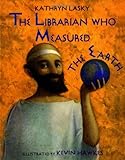The Solution to Reading Comprehension
Lessons & Units :: The Librarian Who Measured the Earth 3rd Grade Unit
Read-Aloud Lesson: The Librarian Who Measured the Earth
Lesson Plan
The Librarian Who Measured the Earth | AD840L

- Learning Goal
- Identify the questions Eratosthenes asks throughout his life to determine the relationship between asking questions and making discoveries.
- Duration
- TBD
- Necessary Materials
- Provided:
- Detailed lesson plan
- Graphic organizer for guided practice
- Independent student worksheet
Not Provided:
The Librarian Who Measured the Earth
-
This lesson is a close reading of the entire text. So it’s important to engage students often, to enhance their learning. Here are two tips:
- When you ask the more complex questions from the lesson, ask students to “turn-and-talk” or “buddy-talk” before answering.
-
Once you are deep into the lesson, instead of asking students every question provided, ask them to share with you what questions they should be asking themselves at that point in the text. This is also a great opportunity to use "turn-and-talk."
- Suggested teacher language is included in the lesson.
- We recommend you read the book once to your students, either the day or morning before teaching the lesson.
- This research-based, read-aloud lesson may seem long. Why do students need the lesson to be this way?
Part 1: Teacher Modeling and Questioning
Write the following student-friendly learning goal on the board, then read the learning goal out loud with the class:
We will look at the questions asked by a man named Eratosthenes and see how those questions led to a discovery.
Prepare Students for the Lesson
Show students where Greece, Libya, and Cyrene are on a map. Two maps are provided with this lesson for your convenience.
Transition Students into the Text
Teacher says: How could a person measure the distance around something as big as the earth? We’re going to read a story about someone who figured out how to do it.
Read pages 5 and 6 out loud, then stop. Page 6 ends with, "...couldn't answer." If possible, always show students the illustrations accompanying the pages you read throughout the lesson.
1.
Teacher asks: What words does the author use to describe Eratosthenes as a baby?
Students answer: The author uses the words “curious” and “full of wonder” to describe Eratosthenes as a baby.
If students struggle with this question, reread the first sentence on page 6: “Even as a baby, Eratosthenes was curious and full of wonder.”
2.
Teacher says: The author gives examples of Eratosthenes’ curiosity. One example is Eratosthenes wondering why there were water droplets on the cistern in the morning. A cistern is a big container for holding liquid.
3.
Teacher asks: What is another example of Eratosthenes’ curiosity?
Students answer: Answers may include any of the following.
- Eratosthenes would crawl across the kitchen to follow ants.
- Eratosthenes would look at the night sky and wonder why the stars stayed there.
- Eratosthenes asked lots of questions. (Students may identify specific questions Eratosthenes asked. If so, you may use the opportunity to segue into Steps 7 and 8 below.)
4.
Teacher says: After Eratosthenes learned to talk, he started asking questions. He asked over a thousand of them.
5.
Teacher asks: What are some of the questions Eratosthenes asked?
Students answer: Answers should include at least two of the following:
- How far away is the sun?
- What is the sun made of?
- Where do the winds come from?
- What makes the stars move?
Part 2: Guided Practice and Discussion
For this oral lesson, it is suggested to have the completed graphic organizer on the board with the answers concealed before this part of the lesson. After students provide a correct answer, reveal the corresponding answer on the graphic organizer.
Transition Students into the Guided Practice
1.
Teacher says: In the first part of the lesson, we looked at many different questions that Eratosthenes asked. Now we are going to organize those questions by group.
2.
Teacher says: Let’s start with the questions that Eratosthenes asked as a little boy, living at home in Cyrene. One question he asked then was, “How far away is the sun?”
3.
Teacher asks: What other questions did Eratosthenes ask as a little boy living at home?
Students answer:
- What is the sun made of?
- Where do the winds come from?
- What makes the stars move?
All questions asked by Eratosthenes are provided for students at the top of the graphic organizer. The questions are arranged in groups of three. Challenge students to match each group of questions with the correct “Where” category on the graphic organizer as you proceed with the lesson.
4.
Teacher says: When Eratosthenes turned six years old, he went to the gymnasium, or school.
Part 3: Student Independent Practice
Both the student question set and teacher answer sheet are provided in the 'Text & Materials' section.
Texts & Materials
Standards Alignment
(To see all of the ReadWorks lessons aligned to your standards, click here.)





